It may seem crazy but the tiny inactive binders and fillers in your thyroid medication have the potential to dramatically impact how well that medication works for you.
We often take these binders and fillers for granted because their dose is so small but the reality is that they can and do make a difference.
These small differences are typically unnoticeable for the average person but when you get to the extremes, they become more obvious and more apparent.
And I would certainly consider thyroid patients, by virtue of how thyroid dysfunction impacts every aspect of the body (1), to be living on the extreme ends of any spectrum.
For this reason, it’s actually very important for thyroid patients to pay attention to small details including the inactive binders and fillers in their medications.
It may surprise you to know, then, that the most commonly prescribed medications used to treat hypothyroidism and Hashimoto’s are loaded with fillers and dyes and these ingredients have the potential to cause problems.
Savvy thyroid patients have known about this issue for a long time which is why thyroid medications like Tirosint, Tirosint-Sol, and WP thyroid (even though it’s not currently available) have become so popular among thyroid groups.
I’m not suggesting that these other medications aren’t effective but we have to accept reality and that reality is many thyroid patients will struggle to convince their doctor to change to these lesser-known thyroid medications.
Does this mean that the group of patients using more conventional thyroid medications like levothyroxine and Synthroid need to suffer needlessly just because their doctor isn’t knowledgeable on these topics?
Not at all.
One potential solution to this problem is what I call the 50 mcg levothyroxine medication hack (it also works for Synthroid as well).
This hack makes use of the unique properties in the 50 mcg tablet of levothyroxine and Synthroid and allows a cheap and quick alternative to making a more dramatic change to lesser-known thyroid medications like Tirosint.
DOWNLOAD FREE RESOURCES
Foods to Avoid if you Have Thyroid Problems:
I’ve found that these 10 foods cause the most problems for thyroid patients. Learn which foods you should avoid if you have thyroid disease of any type.
The Complete List of Thyroid Lab tests:
The list includes optimal ranges, normal ranges, and the complete list of tests you need to diagnose and manage thyroid disease correctly!
Why the 50mcg Tablet of Synthroid & Levothyroxine is Different
As I alluded to above, the 50mcg tablet of both Synthroid and levothyroxine is unique among all other strengths and doses in that it doesn’t contain any extra dyes.
Both levothyroxine and Synthroid still contain inactive fillers and binders, that’s for sure, but the 50mcg strength tablets contain the fewest of all other doses.
By strength, I’m referring to the dose because, as you probably already know, the dose that each thyroid patient needs is slightly different.
These different strengths were created to more easily provide thyroid patients with different ways to get to the necessary dose for their body.
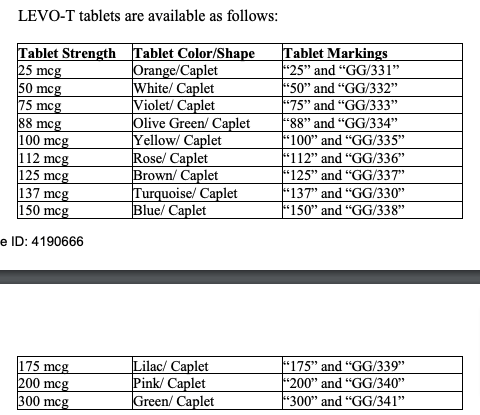
And the strengths were color-coded to make the process of identifying different strengths easier and to prevent issues with accidental overdose/underdose (2).
The colorings and markings on each individual tablet provide a clear way to distinguish one dose from another which means mistakes by your pharmacist are less likely.
As a patient, you would also likely notice if your regular dose of levothyroxine was always purple and then suddenly you received an orange tablet in its place.
This would cause some alarms to go off in your head and probably prompt you to make sure you were given the right medication and dose.
So these markings and dyes aren’t all bad, but they do carry with them a cost:
The potential to cause problems (3) with the absorption and utilization of thyroid hormone in thyroid patients.
This probably all makes sense so far but critical readers will likely look at this information and think to themselves whether or not it’s possible that such a small factor could actually influence how someone reacts to a given medication.
Your skepticism is warranted, but I can tell you from personal experience that it absolutely has the potential to make a difference.
There’s no shortage of thyroid patients out there who notice mild to moderate positive changes when making even the simplest of changes to their thyroid medication.
This could be something as easy as switching from levothyroxine to Synthroid (or vice versa) or changing up the time of day that they take their medication from morning to night.
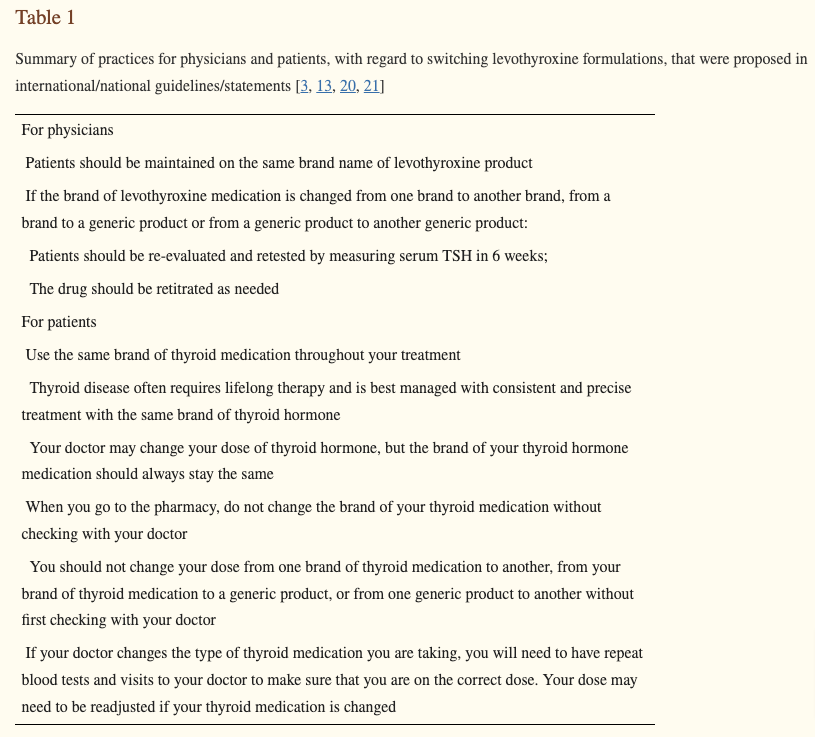
You will see countless examples of changes like these making a difference in how patients feel.
It doesn’t make logical sense that such a small dose of dyes or fillers would have such a large impact on the utilization of thyroid hormone but I’m here to tell you that it can.
But even if it didn’t, or even if you weren’t sure that it could, what’s the logical downside to making the change?
There really aren’t any risks with what I’m suggesting here, only potential upsides.
For this reason, it’s worth a shot if what you are currently taking or using isn’t working for you.
But the question is, how can you take advantage of this hack?
It’s actually very easy and I will walk you through that in just a second but for now, I want to go over the ingredients found in both levothyroxine and Synthroid to help you better understand why making this change may be necessary.
List of Fillers & Binders in Every Levothyroxine Tablet
Every single tablet of levothyroxine contains the following ingredients (4):
- Magnesium stearate (inactive)
- Microcrystalline cellulose (inactive)
- Colloidal silicon dioxide (inactive)
- Sodium starch glycolate (inactive)
- And synthetic T4 thyroid hormone (active)
In addition to these ingredients, additional colorings are added to various doses of levothyroxine by strength:
- 25 mcg tablet – FD&C Yellow No. 6 Aluminum Lake.
- 50 mcg tablet – None.
- 75 mcg tablet – FD&C Blue No. 2 Aluminum Lake, D&C Red No. 27 Aluminum Lake.
- 88 mcg tablet – FD&C Blue No. 1 Aluminum Lake, D&C Yellow No. 10 Aluminum Lake, D&C Red No. 30 Aluminum Lake.
- 100 mcg tablet – D&C Yellow No. 10 Aluminum Lake, D&C Red Lake Blend (D&C Red No. 27 Lake and D&C Red No. 30 Lake).
- 112 mcg tablet – D&C Red No. 27 Aluminum Lake, D&C Red No. 30 Aluminum Lake.
- 125 mcg tablet – RD&C Yellow No. 6 Aluminum Lake, FD&C Red No. 40 Aluminum Lake, FD&C Blue No. 1 Aluminum Lake.
- 137 mcg tablet – FD&C Blue No. 1 Aluminum Lake.
- 150 mcg tablet – FD&C Blue No. 2 Aluminum Lake.
- 175 mcg tablet – D&C Red No. 27 Aluminum Lake, D&C Red No. 30 Aluminum Lake, FD&C Blue No. 1 Aluminum Lake.
- 200 mcg tablet – D&C Yellow No. 10 Aluminum Lake, D&C Red No. 27 Aluminum Lake.
- 300 mcg tablet – D&C Yellow No. 10 Aluminum Lake, FD&C Yellow No. 6 Aluminum Lake, FD&C Blue No 1 Aluminum Lake.
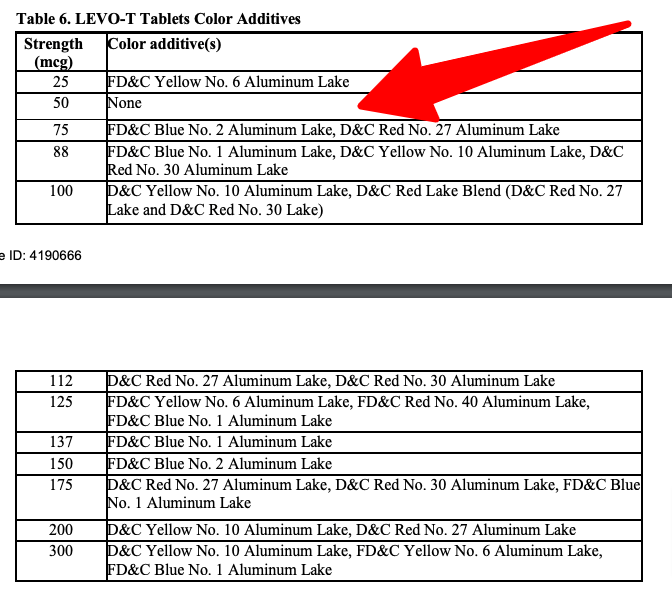
Levothyroxine is by no means the cleanest thyroid medication on the market but it’s clear that the 50mcg tablet is the cleanest of all other doses because it doesn’t contain any extra dyes.
List of Fillers & Binders in Every Synthroid Tablet
Every single tablet of Synthroid contains the following ingredients (5):
- Acacia (inactive)
- Confectioner’s sugar (inactive)
- Lactose monohydrate (6) (inactive)
- Magnesium stearate (inactive)
- Povidone (7) (inactive)
- Talc (inactive)
- And synthetic T4 thyroid hormone (active)
In addition to these ingredients, additional colorings are added to various doses of Synthroid by strength:
- 25 mcg tablet – FD&C Yellow No. 6 Aluminum Lake.
- 50 mcg tablet – None.
- 75 mcg tablet – FD&C Red No. 40 Aluminum Lake, FD&C Blue No. 2 Aluminum Lake.
- 88 mcg tablet – FD&C Blue No. 1 Aluminum Lake, FD&C Yellow No. 6 Aluminum Lake, D&C Yellow No. 10 Aluminum Lake.
- 100 mcg tablet – D&C Yellow No. 10 Aluminum Lake, FD&C Yellow No. 6 Aluminum Lake.
- 112 mcg tablet – D&C Red No. 27 & 30 Aluminum Lake.
- 125 mcg tablet – FD&C Yellow No. 6 Aluminum Lake, FD&C Red No. 40 Aluminum Lake, FD&C Blue No. 1 Aluminum Lake.
- 137 mcg tablet – FD&C Blue No. 1 Aluminum Lake.
- 150 mcg tablet – FD&C Blue No. 2 Aluminum Lake.
- 175 mcg tablet – FD&C Blue No. 1 Aluminum Lake, D&C Red No. 27 & 30 Aluminum Lake.
- 200 mcg tablet – FD&C Red No. 40 Aluminum Lake.
- 300 mcg tablet – D&C Yellow No. 10 Aluminum Lake, FD&C Yellow No. 6 Aluminum Lake, FD&C Blue No. 1 Aluminum Lake.
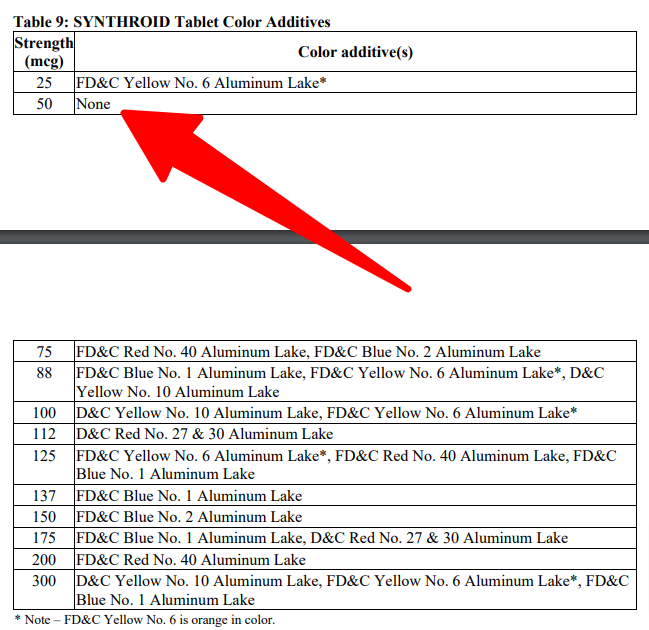
You’ll notice that just like levothyroxine, the Synthroid 50 mcg tablet does not contain any extra dyes.
It’s also worth pointing out, in case you glossed over it, that Synthroid does contain a small source of lactose as lactose monohydrate.
The use of lactose as a filler is not uncommon with prescription medications and the general consensus from the medical community is that the dosing is so small that it typically doesn’t cause problems for most people even if they are lactose intolerant.
My experience suggests that lactose can be a problem for some thyroid patients but there are plenty who are able to tolerate Synthroid without any issues.
Having said that, it’s likely not worth using Synthroid in certain situations such as those with Hashimoto’s because there are cleaner options available and because dairy products may make thyroid function worse (8).
But if you find that Synthroid is the only medication that helps you feel better then stick with what’s working.
How to Use The 50mcg Tablet Hack
From a practical standpoint, taking advantage of this hack is quite easy.
Here’s what you need to do:
Step #1. Identify how much levothyroxine or Synthroid you are currently taking.
Step #2. Divide that dose by 50mcg. This will give you the number of tablets you need to take to equal your old dose.
Step #3. Ask your doctor to prescribe you your regular dose of thyroid medication in increments of 50mcg tablets, based on the number you obtained in step #2.
Step #4. Take your thyroid medication as you would normally while paying attention to your symptoms and keeping an eye on your thyroid lab tests. Some patients will see an improvement in thyroid function which may necessitate altering their overall dose (this would be a good thing).

The math is pretty easy here but let me walk you through a few examples to give you an idea of how it would work.
Example #1: You are using 125mcg of levothyroxine each day.
In this case, you would take your dose of 125 mcg and divide it by 50 mcg.
This would give you a value of 2.5.
That 2.5 value means that you need to take 2 and 1/2 capsules of 50 mcg tablets to equal your old dose.
You would then ask your doctor to change your prescription of levothyroxine to this:
Levothyroxine 50 mcg tablet, take 2 and a half tablets each day.
I used this example to show you that this hack does work for doses that come in intervals of 25 mcg, it will just require that you cut your 50 mcg tablet in half to get there.
So it will work for 25 mcg, 75 mcg, 125 mcg, 175 mcg, 225 mcg, and 275 mcg.
Example #2: You are taking 150 mcg of Synthroid each day.
If you are taking 150 mcg of Synthroid each day then you would take your dose of 150 mcg and divide it by 50 mcg which would give you a value of 3.
This means you would need to take 3 tablets of 50 mcg of Synthroid to equal your old dose of 150 mcg.
You would then ask your doctor to change your prescription to this:
Synthroid 50 mcg tablets, take 3 tablets each day (Dispense as written).
Adding the dispense as written is important in this situation because it would prevent the pharmacist from automatically giving you the generic version (levothyroxine) instead of Synthroid.
Obviously, this hack works for all doses that come in 50 mcg increments including 50 mcg, 100 mcg, 150 mcg, 200 mcg, 250 mcg, and 300 mcg.
Example #3: You are taking 88 mcg of levothyroxine each day.
Unfortunately, this hack doesn’t work very well for doses that do not come in intervals of 50 mcg or 25 mcg like the following doses:
88 mcg, 112 mcg, and 137 mcg.
Your only option if you are using any of these doses is to try and increase or decrease your dose to a 25 mcg or 50 mcg increment or to try a completely different thyroid medication like Tirosint (more on this below).
It’s fairly easy to cut a tablet in half but it becomes much less accurate when you try to cut a tablet into quarters which would be necessary to achieve these doses.
Is Your Thyroid Medication Helping You Feel Better?
I know this can sometimes get lost in translation but the entire purpose of using thyroid medication is to help you feel better.
If you have been given thyroid medication (which should be the case if you are reading this) then it was given to you for a purpose.
And that purpose was to eliminate your low thyroid symptoms.
You haven’t been prescribed this medication just for fun.
It was meant to make up the difference between what your thyroid gland is producing and what it should be producing if it were healthy.
Sometimes thyroid patients get so focused on numbers and lab test results that they forget this simple lesson.
With this in mind, I have a question for you:
Is your thyroid medication helping you feel better?
And by feeling better what I am really asking is if your thyroid medication has resolved your low thyroid symptoms.
If the answer is no, then there’s something wrong with your current regimen.
There are lots of reasons why this occurs including the simple fact that your dose is off but it could very well be the case that the inactive binders and fillers are preventing your body from completely using your thyroid medication.
In situations such as these, giving this hack a try would be one simple change you could consider making.
Some Other Options & Considerations
The entire purpose of this article is to show you that making small changes to your thyroid medication can have a big impact on your thyroid symptoms.
And the information I’ve shared here is one way to do that but there are many others.
Some thyroid patients will read this article and get upset that I didn’t include other options and that I only discussed levothyroxine and Synthroid.
They will suggest that making the change to something like Natural Desiccated Thyroid is the preferred option and will result in a better outcome.
And while there is truth to that statement you always have to keep in mind the current situation that most thyroid patients find themselves in.
Many thyroid patients, the majority, in fact, are getting their medication from doctors that live in a world where levothyroxine is king.
Getting the average endocrinologist or family practice doctor to switch you from levothyroxine to Armour thyroid is far more difficult than getting them to switch your dose to 50 mcg increments of the same medication you are already taking.
This means that this hack probably has far more utility for the average thyroid patient even if it is less effective compared to other thyroid medications.
If you are one of the lucky few thyroid patients that do have a thyroid-literate doctor then these changes may be superior to the 50 mcg levothyroxine medication hack:
- Switching from levothyroxine to Tirosint or Tirosint-Sol
- Switching from levothyroxine to NDT like Armour Thyroid or NP Thyroid
- Switching from levothyroxine or Synthroid to Compounded T4 + T3 Hormone
And, as always, your mileage may vary so keep that in mind as you tackle the complex topic of thyroid medication management.
Now I want to hear from you:
Were you aware that levothyroxine and Synthroid contain all of these additional dyes and colorings?
Did you know that inactive binders and fillers can cause problems with the utilization of your thyroid medication?
Do you feel that your symptoms are managed on your current thyroid medication?
Do you think that the fillers and colorings might be causing an issue in your body?
Leave your questions or comments below to keep the conversation going!
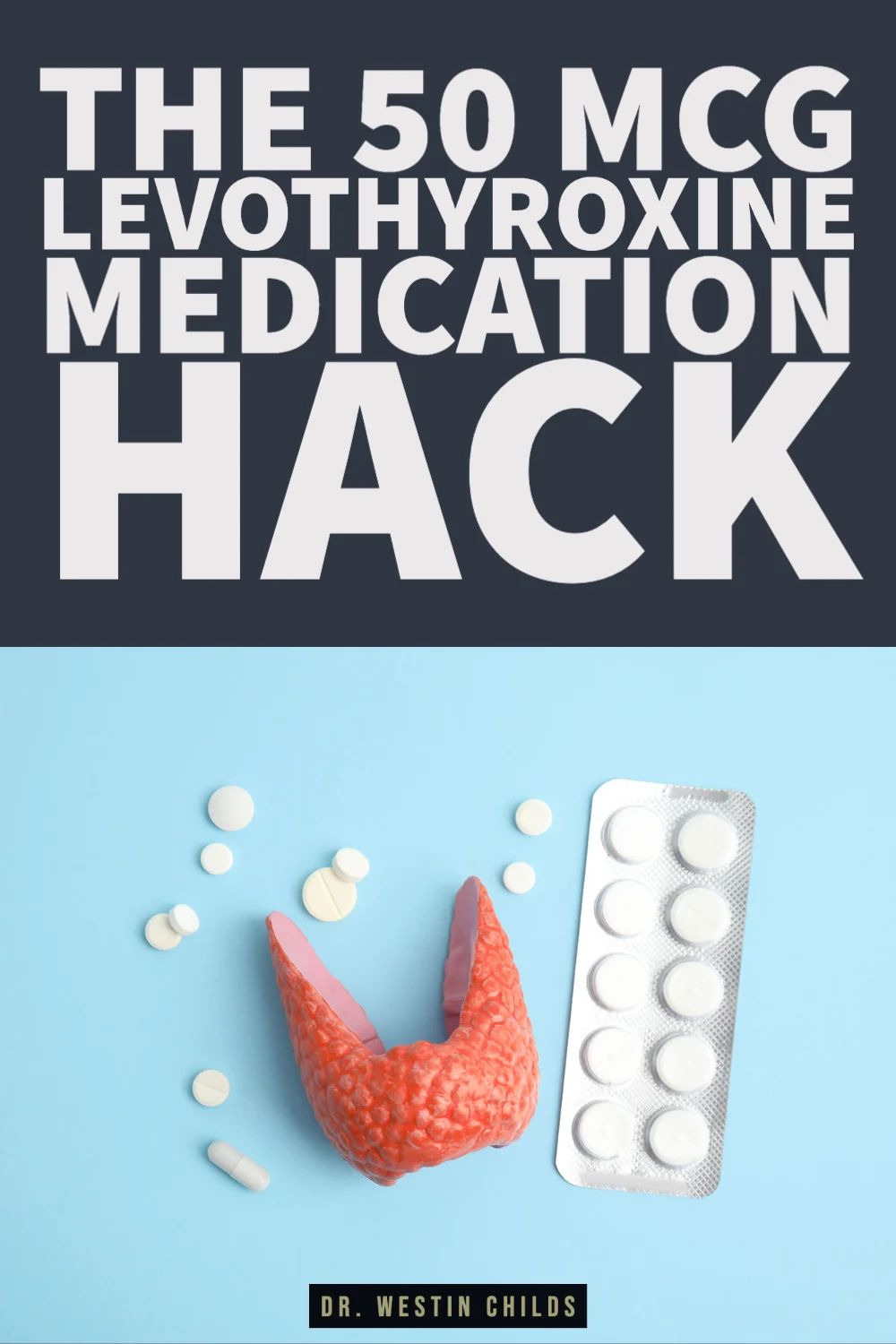
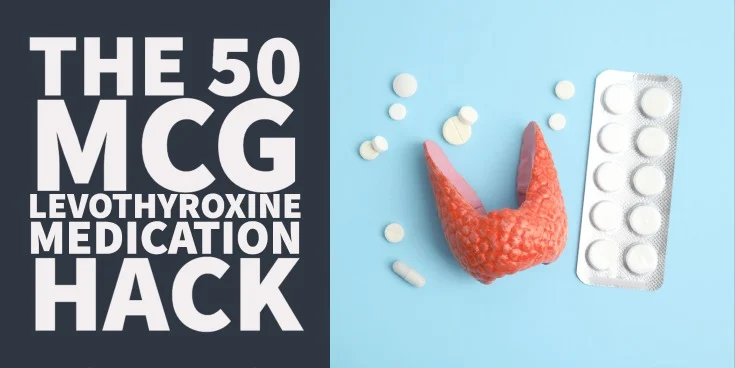

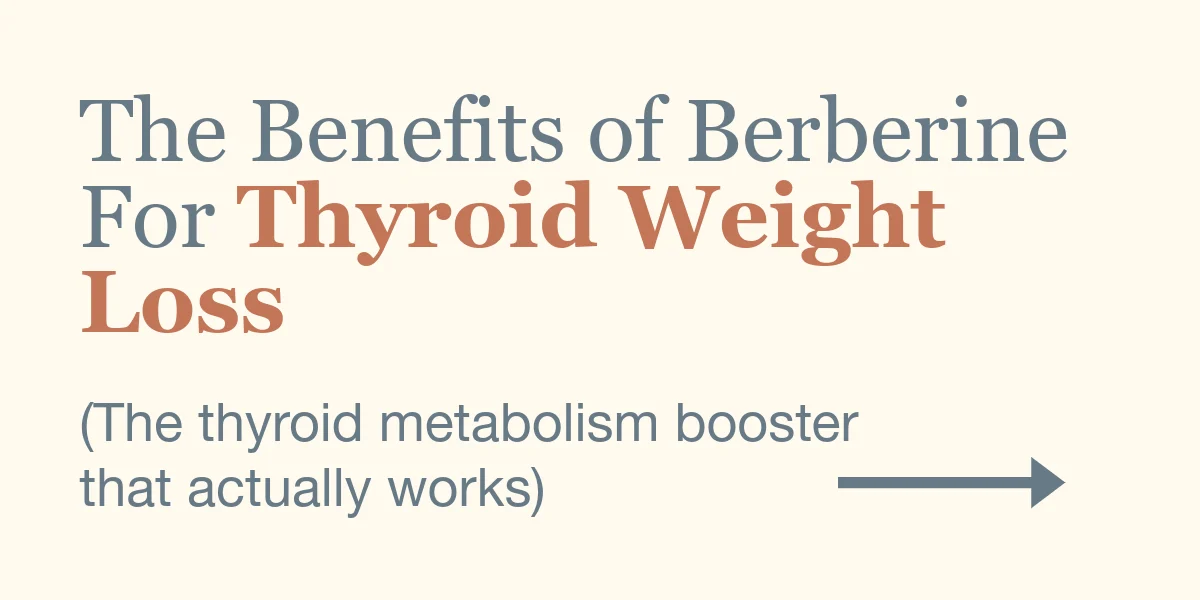
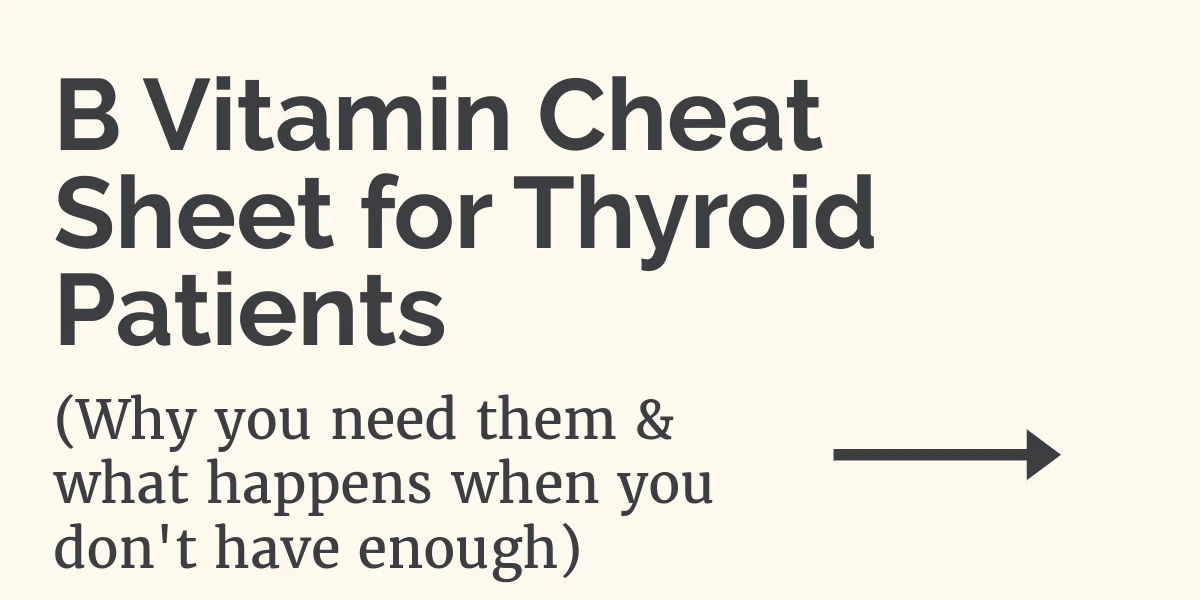
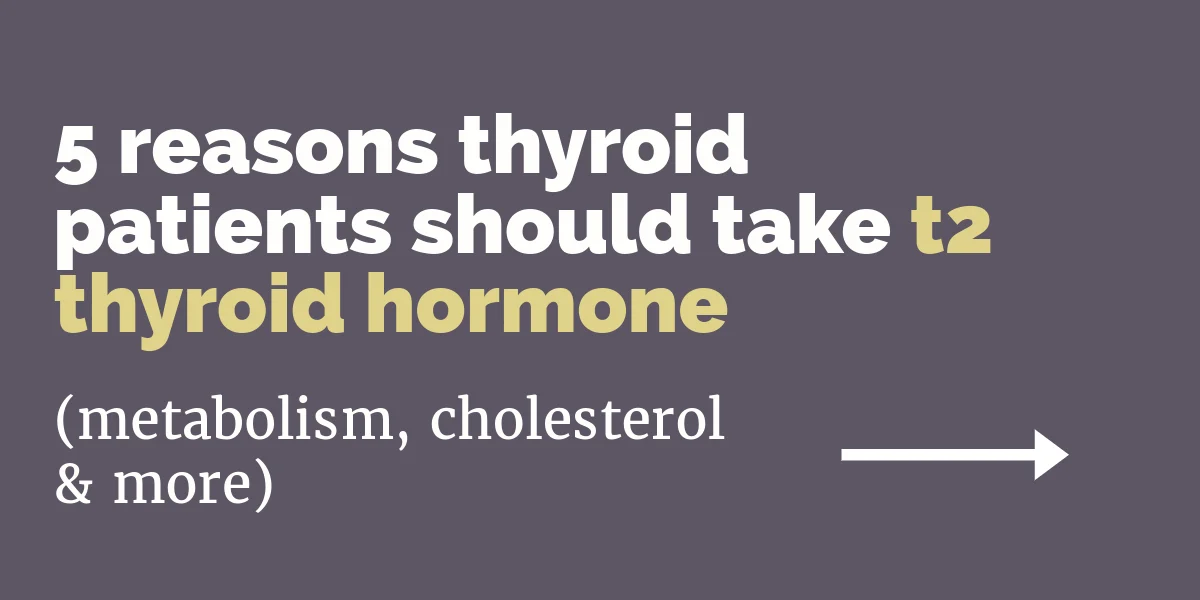
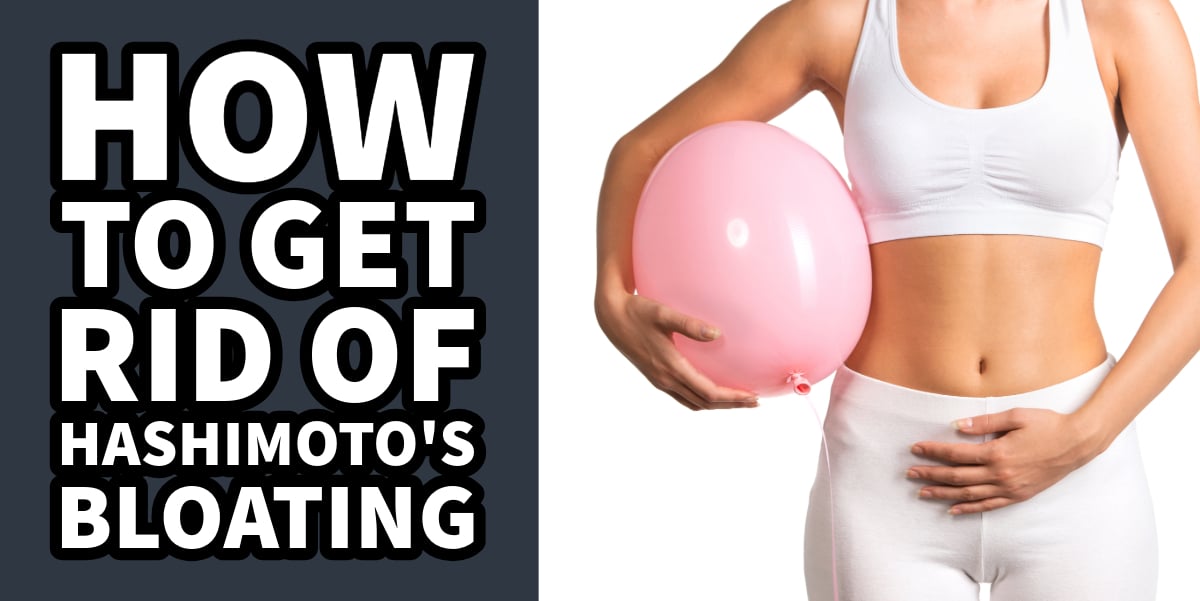

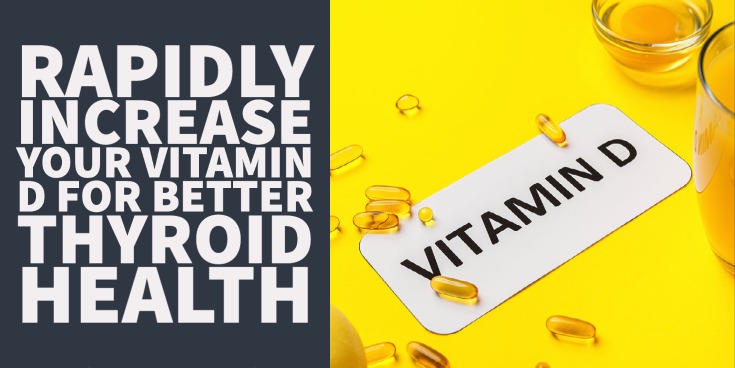

Do vibration plates help with Hashimotos pain?
Hi Susan,
Vibration plates could certainly be helpful if you have Hashimoto’s but it’s unlikely to significantly impact thyroid function if used all by themselves. If combined with other treatments, however, it could be a nice therapy to augment whatever you are currently doing.
I absolutely had a problem with the yellow dye in the generic T4 medication my doctor prescribed. I was allergic to it, because I broke out in hives after taking it,. I called my doctor, and asked him to please put on my prescription that I needed Synthroid 50 mcg only, and not to substitute with the generic. He basically called me either a person who was either not telling the truth, or was just wanting attention. He said he had never heard of anyone being allergic to the generic version of the Synthroid before. I said I am very allergic to all kinds of dyes and perfumes, and fabric softeners, paint fumes, etc, and I knew I was allergic to this medication, and to please switch it out. He finally reluctantly agreed to do it, but then the wrestling with the insurance began, because I had filled the prescription. After INSISTING that I needed to switch to the brand name with no dyes, I had to pay out of pocket for the medicine, and it reduced my refills unnecessarily, but the pharmacy did refill it with the brand name. I have not had the hives with the synthroid 50 mcg. I also do not respond as well to the generic version of the medicine, even if it does not have any of the dyes, as tested out another time when I got a generic version of the medicine, and the pills were white. I think with that bottle, it must have been the different fillers interfered, because I was severely hypothyroid after taking that bottle. I now have to remind the pharmacy staff each time I get the Synthroid filled at the pharmacy to refill with brand name only, and I physically check the bottle before I leave the counter, so I do not get the generic medication instead of brand name. I do not feel my levels are at optimum, and feel I am barely surviving on my current dose of 50 mcg of Synthroid, and 20 mcg of Cytomel (10 mcg 2 times daily) regimen. I had to beg, scream, and cry to get the Cytomel, and every six months have to beg to keep on it, because my TSH level is undetectable. However, if I go any less than this dose, after 5 weeks, I am in the hospital for extremely high blood pressure, severe bloating in my abdomen, unbearable constipation, and being freezing cold, to name just a few symptoms. The worst is the high blood pressure. I have had thyroid cancer in 2011, and radioactive iodine treatment afterwards, and have never felt like my doctors have been able to get me to an optimum level.
Formulations like Tirosint should be the norm in thyroid therapy. It’s ridiculous with the near 100% absorption of capsule and liquid forms that tablet forms are still allowed to label, for example, a dose as 100mcg when if you’ve taken Tirosint you will know that the tablet form is not 100mcg. Unlike the makers of Levoxyl, Synthroid and other brands, Tirosint has a very fair and reasonable direct and discount program to make their Levothyroxine affordable. Now if only we could get T3 in capsules and different doses, without having to get it from compounding pharmacies. One of the benefits of Tirosint is that it comes in blister packs and no plastic bottles. I feel safer knowing it’s packaged straight from the factory without any human interference.
Thank you, Dr. Childs, for your informative and inspiring articles. I knew about the fillers and dyes in Levothyroxine and Synthroid, which I had been using for decades after radioidine treatment (for Graves) and felt wary about, since the the dyes (in the 100 mcg yellow tablets) would accumulate in the liver and who knows where else in the body. So after reading on alternative NDT, I managed about 4 years ago to transition gradually to 1.75 grain compounded capsules with no fillers (except ginger powder or, preferably cocoa butter) and have never felt better since becoming hypo after the destruction of my thyroid glad. My TSH always comes out as “too low” in standard lab reports, but my T4 and T3 are normal, I have good energy and feel that the full thyroid hormone panel is reaching every body tissue as it should. My only concern is whether the dosis should be adjusted downward with higher age (am 69, female). What would you suggest based on your experience?
Hi AJ,
I can’t provide personal medical advice but, in general, there’s no need to adjust dosing if you aren’t experiencing negative side effects and if your symptoms are generally well-controlled. There are some risks involved when suppressing the TSH that you should be aware of, though, and this should be taken into account when determining how to proceed with thyroid medication dosing. You can learn more about those risks here: https://www.restartmed.com/low-tsh-vs-suppressed-tsh-on-thyroid-medication/
Hi, Dr Childs — I’ve had to do my own research since I was diagnosed with Hashimoto’s 3 yrs ago because none of the doctors/endocrinologists where I live know ANYthing about the disease. Everything you say resonates with what I’ve learned, but nothing–not diet nor changing my thryoid Rx has helped with chronic rashes. Until I tried LDN (@ 4.5 mg)–miraculous! These rashes began after a bad reaction to Amoxycillin, which I’ve since discovered can trigger the Epstein-Barr Virus.
I know that Hashimoto’s is caused by EBV, with whom I have a long relationship dating back to chicken pox in childhood and mono in high school. My dermatologist recently prescribed a prophylactic dose of Valtrex (5 days) before/after a laser treatment, which he said can trigger the herpes virus; nonetheless, I broke out in a chicken pox-like rash on my face afterwards. He prescribed another round of Valtrex (7 days) and my rash went away after ONE DAY. Since Hashimoto’s entered my life, I’ve noticed that I have body odor within a few hours of taking a bath, as if my body can’t fight off the bacteria. That went away after the Valtrex.
So here’s my question (finally): what are your thoughts on using Valtrex long-term for Hashimoto’s? I’ve always preferred natural treatments & supplements but I’ve finally accepted the necessity of drugs because they make me feel better. (Nothing has helped my fatigue yet, however.) Thank you–I’ve started taking my Synthroid + Liothyronine sublingually thanks to your suggestion.
Hi Judith,
I have seen Valtrex benefit some patients with Hashimoto’s but I’ve also seen plenty of patients take it without any response whatsoever. It’s not clear to me how to determine who will benefit from it and who will not without some trial and error.
If you are trying to avoid prescription anti virals, there are plenty of supplements to consider as well.
Any thoughts on using Valaciclovir for Hashimoto’s? I have the EBV virus (chickenpox in childhood/mono as a teenager) and recently did a prophylactic dose of Valtrex for a laser treatment. I still had a chickenpox-like outbreak on my face afterwards but the next course of Valtrex cleared it up within a day. I’ve tried to use natural supplements/diet for my Hashimoto’s in addition to the 50 mg Synthroid + Liothyronine but nothing has helped the fatigue. I know there are antiviral herbals but I don’t know if they’re effective. Thank you!
Hi Judith,
I have seen some success in select Hashimoto’s patients when using anti-virals like valacyclovir.
My prescription container says Synthroid 137 mcg but under it says Levothyroxine Sodium.
I’m confused because the article says those are two different medications.
Hi Toni,
Synthroid is the brand name and levothyroxine is generic. They differ slightly in their inactive ingredient profile but the active ingredients are identical. This small difference in inactive ingredients is enough to make a difference for some people, though.
Hi. I’m just out of Thyroidectomy in May and am on 100 mcg Euthoyroxine. It’s white so no dye I assume and no need to use the 50 mcg trick. I will be starting on Cytomel 5 mcg as something is off. I still don’t feel myself
Hi Zweiz,
You’ll have to look at the ingredient list for Euthyroxine to make sure the 100mcg tablet doesn’t contain any dyes. Each formulation is different and this information only applies to levothyroxine and Synthroid.
I use Euthyrox because I didn’t like the dye in the levothyroxine tablets but I don’t feel any different. My TSH number seemed to improve a little when I first switched. My T3 and T4 are normal and TSH is about 4 but has been down to 2 – it fluctuates. I still have fatigue.
Is Euthyrox free of fillers also? I was told it was but not sure since nothing is said on package. The pills are manufactured by Merck in Germany.
Hi Carol,
You can see the complete ingredient list for Euthyrox here: https://www.accessdata.fda.gov/drugsatfda_docs/label/2018/021292s004%2C021292s005%2C021292s006lbl.pdf
At a quick glance, I didn’t see any color additives.
I have been taking Unithyroid for awhile now …. Around 8 months vs Levothyroxine and I take many of your Hashimoto supplements as well but, I never hear from you about Unithyroid. Could you tell me the pros and cons of this med? Thxs!
Hi Willie,
I will add it to the list of future topics to write about and discuss!
Dr. Childs
Do the tirosint capsules have dyes that indicate the dosage?
Hi Tony,
No, this dye issue is specific to variations of levothyroxine and Synthroid.
Hello Dr Childs
Thank you so very much for all your dedication and information circulated to the many that receive benefit.
My journey is long and quite harrowing to say least, sadly caused by our ill informed and cost saving driven Drs in the U.K.
Following debilitating allergic responses to pharmaceutical thyroxine, I survived profound hypothyroid / pre coma. I was then elevated to extreme hyperthyroidism when given the massive 150mcg m dose of liquid thyroxine.
I’m sure you’ll understand how traumatic this all was on the body Since surviving this, I trust no Drs here and now manage myself best I can and purchase pure thyroxine to do so.
So to sum up the reactions to these fillers can be very extreme and in my case debilitating and life threatening.
Thank you again for all you do.
You’re an outstanding light in this field of extreme darkness in the medical community.
Blessings to you and yours.
Hi Jayne,
Happy to help and glad you find the information helpful! Thanks for sharing your experience as well.
I have had thyroid cancer and had my thyroid removed with a little portion remaining. My endocrinologist has prescribed 88 mcg levothyroxine. Started out on 125 mcg, then 112 mcg, and now 88 mcg over a period of about 5 years. My energy level is low in the mornings, peaks maybe in the afternoon, then drops in the evenings. Some days my energy level is so low I don’t want to do anything. I was going to ask my doctor to change me to Synthroid but now I am reconsidering. Apparently my t3 & t4 are where my doctor wants them but I don’t feel energetic.
Hi Karen,
Where your doctor wants your T3 and T4 levels and where they should actually be are two completely different numbers! You can learn more here: https://www.restartmed.com/normal-thyroid-levels/
I’ve been on Tirosint for a few years, but recently heard that my insurance company (BCBS) won’t cover it, unless I try 3 other generic options and can’t tolerate those. I’m so annoyed by their decision, since I like the clean Tirosint option, but thank you for highlighting this 50mcg hack! I may be forced to try it!
Hi Cheri,
Glad you found it helpful!
I had a bad experience on Levo 125.
The ingredients made me feel like I was being poisoned with headaches and general feeling unwell.
I was switched to the same dose but with the white 50 tablets. It was such a huge difference! No more disturbing symptoms.
Listen to your body, it’s everything.
Hi Rebecca,
Glad to hear the small change helped and thanks for sharing!
Would you recommend taking T2, T3 & glandulars at the same time as NP Thyroid or should they be taken separately?
Hi Kristen,
You can usually get away with taking T2 and T3 at the same time as NDT but the glandular should be taken away from thyroid medication.
What would happen if I stopped taking Cytomel? Are there any T3 meds without gluten?
Hi Diane,
You can learn more here about what happens when you abruptly stop taking thyroid medication: https://www.restartmed.com/side-effects-of-stopping-thyroid-medication/
One version of Levothyroxine caused burning down my entire GI trac and another caused a red rash all over my face down my neck and chest. If there isn’t a visible reaction the drs say you are crazy. Synthroid affects my mental health for some bizarre reason. At high doses I become paranoid and crazy. Np thyroid has most definitely been the best experience. It’s insane that most endocrinologist refuse to prescribe this medicine you have to do your research to find one who will. Why when they have such awful affects and seemingly little benefits for feeling and only change numbers on labs. I feel like I’ve seen or talked with a lot of people with similar experiences so I know I’m not alone in this! Thank you for publicizing this.
Hi Bonnie,
Glad you found it helpful! If you are looking for even cleaner alternatives then you may want to check out Tirosint and Tirosint-sol.